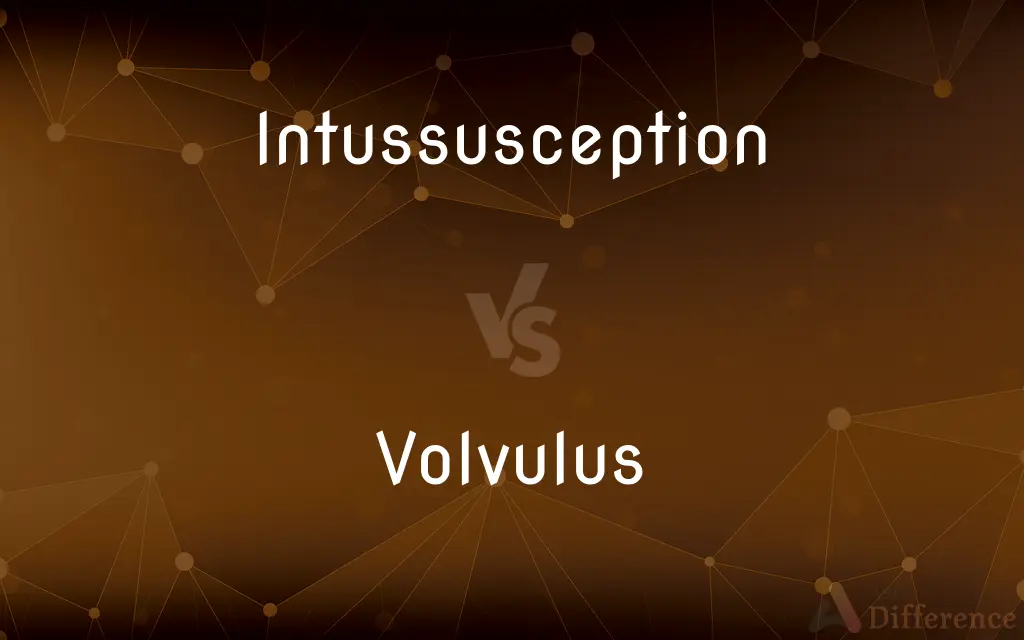Intussusception vs. Volvulus — What's the Difference?
By Tayyaba Rehman & Fiza Rafique — Updated on March 31, 2024
Intussusception occurs when a part of the intestine slides into an adjacent part, while volvulus involves the intestine twisting around itself.

Difference Between Intussusception and Volvulus
Table of Contents
ADVERTISEMENT
Key Differences
Intussusception is a condition where one segment of the intestine telescopes into another, causing blockage. This can lead to symptoms like abdominal pain, vomiting, and bloody stools. It primarily affects infants and young children and can be serious if not treated promptly. Diagnosis is typically made through ultrasound or other imaging studies, and treatment often involves non-surgical methods like air or barium enemas, which can both diagnose and treat the condition by helping to unfold the telescoped segment of intestine.
Volvulus, on the other hand, involves the twisting of a part of the intestine around itself, leading to a blockage that can cut off blood flow to the affected part. This condition can cause severe abdominal pain, vomiting, and constipation or lack of bowel movements. Volvulus can occur at any age but is more common in certain populations depending on the location of the twist. It is diagnosed through imaging techniques such as X-rays, CT scans, or MRIs. Treatment usually requires surgery to untwist the intestine and, if necessary, remove any damaged section.
The main difference between the two conditions lies in their mechanism. Intussusception involves a segment of the intestine sliding into itself, somewhat like how a telescope folds. This can happen anywhere along the intestinal tract but is most common in the junction between the small and large intestines. Volvulus involves a rotation of the intestine around its mesentery, the attachment that keeps the intestines in place, which can lead to a strangulation of the blood supply.
Both conditions lead to obstruction of the intestine, but the outcomes and treatments can differ significantly. Intussusception often resolves with non-surgical intervention and has a good prognosis when treated early. Volvulus, however, more frequently requires surgery to correct the twisting and to assess and possibly remove any part of the intestine that has been harmed due to reduced blood flow.
In terms of demographics, intussusception is most commonly seen in younger patients, especially infants and toddlers, whereas volvulus can have a more varied age distribution, depending on the type and location of the volvulus. For example, sigmoid volvulus is more common in the elderly, while midgut volvulus is more often seen in infants.
ADVERTISEMENT
Comparison Chart
Definition
Sliding of one part of the intestine into another
Twisting of the intestine around itself
Common Age Group
Infants and young children
Any age, with certain types more common in infants or elderly
Symptoms
Abdominal pain, vomiting, bloody stools
Severe abdominal pain, vomiting, constipation
Diagnosis
Ultrasound, air or barium enema
X-rays, CT scan, MRI
Treatment
Non-surgical (air or barium enema), sometimes surgery
Usually requires surgery
Compare with Definitions
Intussusception
Often treated non-surgically with an air or barium enema; surgery if unsuccessful.
The successful air enema avoided the need for surgery in the intussusception case.
Volvulus
Diagnosed using imaging techniques such as X-rays, CT scans, or MRIs.
The CT scan showed a classic whirl sign indicative of volvulus.
Intussusception
Presents with intermittent severe abdominal pain, vomiting, and sometimes bloody stools.
The toddler's repeated episodes of abdominal pain and vomiting were signs of intussusception.
Volvulus
Includes severe abdominal pain, vomiting, and absence of bowel movements.
The elderly patient's volvulus presented with sudden severe abdominal pain and bloating.
Intussusception
Most commonly affects infants and young children.
Intussusception is a leading cause of bowel obstruction in infants.
Volvulus
Requires surgical intervention to untwist and possibly resect affected bowel.
Surgery for the volvulus involved untwisting and removing a necrotic segment of intestine.
Intussusception
A condition where a segment of the intestine telescopes into an adjacent segment.
A child diagnosed with intussusception required an air enema for treatment.
Volvulus
Can occur at any age but certain types are more common in specific populations.
Sigmoid volvulus is more prevalent among the elderly due to chronic constipation.
Intussusception
Typically diagnosed through ultrasound or a barium or air enema.
The radiologist confirmed intussusception on the ultrasound.
Volvulus
A condition characterized by the twisting of a part of the intestine, causing obstruction.
The emergency surgery was performed to correct a sigmoid volvulus.
Intussusception
(Medicine) Invagination, especially an infolding of one part of the intestine into another.
Volvulus
A volvulus is when a loop of intestine twists around itself and the mesentery that supports it, resulting in a bowel obstruction. Symptoms include abdominal pain, abdominal bloating, vomiting, constipation, and bloody stool.
Intussusception
(Biology) Assimilation of new substances into the existing components of living tissue.
Volvulus
Abnormal twisting of the intestine causing obstruction.
Intussusception
(medicine) The invagination of one portion of a tubular anatomical structure (especially intestines or blood vessels) within the next.
Volvulus
(medicine) Obstruction of the bowel in which a loop of bowel has abnormally twisted on itself.
Intussusception
(rare) Absorption.
Volvulus
The spasmodic contraction of the intestines which causes colic.
Intussusception
The reception of one part within another.
Volvulus
Abnormal twisting of the intestines (usually in the are of the ileum or sigmoid colon) resulting in intestinal obstruction
Intussusception
The abnormal reception or slipping of a part of a tube, by inversion and descent, within a contiguous part of it; specifically, the reception or slipping of the upper part of the small intestine into the lower; introsusception; invagination.
Intussusception
The interposition of new particles of formative material among those already existing, as in a cell wall, or in a starch grain.
Intussusception
The act of taking foreign matter, as food, into a living body; the process of nutrition, by which dead matter is absorbed by the living organism, and ultimately converted into the organized substance of its various tissues and organs.
Dead bodies increase by apposition; living bodies by intussusception.
Intussusception
The folding in of an outer layer so as to form a pocket in the surface;
The invagination of the blastula
Intussusception
(biology) growth in the surface area of a cell by the deposit of new particles between existing particles in the cell wall
Common Curiosities
Can intussusception recur?
Yes, intussusception can recur, especially in young children, even after successful treatment.
What causes volvulus?
Volvulus occurs when a part of the intestine twists around itself, potentially leading to blockage and loss of blood supply.
What are the symptoms of intussusception?
Symptoms include episodic abdominal pain, vomiting, and bloody stools.
What is intussusception?
Intussusception is a medical condition where a part of the intestine folds into the section next to it, causing blockage.
Can adults get volvulus?
Yes, adults can get volvulus, though the risk factors and affected population segments may vary.
How is volvulus diagnosed?
Volvulus is diagnosed through imaging tests such as X-rays, CT scans, or MRIs showing twisted intestines.
Is there a way to prevent intussusception?
There is no known way to prevent intussusception; it occurs spontaneously in most cases.
How quickly should intussusception be treated?
Intussusception requires prompt treatment to avoid serious complications like bowel necrosis.
Who is most at risk for intussusception?
Infants and young children are most at risk for developing intussusception.
What is the treatment for volvulus?
The primary treatment for volvulus is surgery to untwist the intestine and remove any damaged sections.
Can changes in diet prevent volvulus?
While diet changes cannot prevent all types of volvulus, maintaining bowel health can reduce risks for some individuals.
What are the long-term effects of intussusception if untreated?
Untreated intussusception can lead to bowel necrosis, perforation, and potentially life-threatening infections.
What complications can arise from volvulus?
Complications can include intestinal necrosis, perforation, and sepsis if not treated promptly.
Is surgery always required for intussusception?
Not always; many cases can be treated with non-surgical methods like air or barium enemas.
What is the prognosis for volvulus?
With timely surgical intervention, the prognosis for volvulus can be good, but delays can lead to serious complications.
Share Your Discovery

Previous Comparison
Truthful vs. Honest
Next Comparison
Sponsoree vs. SponsorAuthor Spotlight
Written by
Tayyaba RehmanTayyaba Rehman is a distinguished writer, currently serving as a primary contributor to askdifference.com. As a researcher in semantics and etymology, Tayyaba's passion for the complexity of languages and their distinctions has found a perfect home on the platform. Tayyaba delves into the intricacies of language, distinguishing between commonly confused words and phrases, thereby providing clarity for readers worldwide.
Co-written by
Fiza RafiqueFiza Rafique is a skilled content writer at AskDifference.com, where she meticulously refines and enhances written pieces. Drawing from her vast editorial expertise, Fiza ensures clarity, accuracy, and precision in every article. Passionate about language, she continually seeks to elevate the quality of content for readers worldwide.
















































